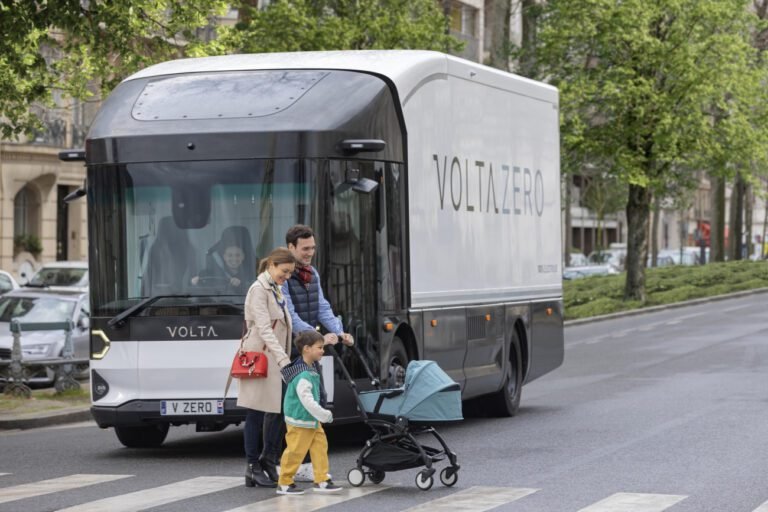Volta Trucks, a fully electric commercial vehicle manufacturer and service provider, has set a new industry standard for end-to-end visibility.
With a volume score of 32.82 cubic metres, the Volta Zero rating is the highest ever score of any vehicle tested and 50% higher than the nearest competitor, at 22 cubic metres. It sounds impressive, but what does it mean in practice, and why is it important?
This is important because soon, all commercial trucks operating in and around European cities and urban areas will have to comply with more stringent safety standards, including visibility. Currently, most of them are deficient, so they rely on additional safety measures, such as installing cameras and sensors, to mitigate blind spots.
Direct vision standard
Research into the Direct Vision Standard (DVS) for transportation began in 2016. The Direct Vision Standard (DVS) was conceived as a safety initiative to improve the visibility of heavy goods vehicles (HGVs) from the driver’s perspective. This reduces the risk of accidents between pedestrians, cyclists and other vulnerable road users.
The standard assigns a star rating to vehicles based on the amount of direct view the driver has from the cab.
Transport for London (TfL) in the UK pioneered the DVS concept by commissioning research led by Loughborough University by Dr Steve Summerskill, a senior lecturer and researcher at Loughborough in industrial and ergonomic design. DVS was officially introduced as a requirement for all heavy vehicles over 12 tonnes operating within Greater London from 1 March 2021. This was all part of the Mayor of London’s Vision Zero Plan to eliminate all deaths and serious injuries on London’s transport network by 2021. 2041.
EU General Vehicle Safety Regulation
But it has now gone beyond the UK. Following the adoption of the EU General Vehicle Safety Regulation, 29 countries, including every EU Member State, are also adopting the UNECE direct vision standard for new trucks from 2026 (and all existing trucks from 2029), thus Ensuring that vehicles operating in city centers provide better visibility for the driver.
Speaking about the new standard, Dr Summerskill said: “For years, we have focused on highlighting how poor current truck drivers’ vision is and the risks it poses to vulnerable road users. Thanks to organizations like Transport for London, we have been able to drive change in London, enabling Ultimately leading to a new European standard and it is no exaggeration to say that this change will save the lives of countless cyclists and pedestrians. I am very proud that our work has been able to play a role in this.”
The all-electric Volta Zero
As well as being fully electric, the Volta Zero is designed to be safe, with urban road users, pedestrians, cyclists and drivers in mind. This is because the driver of the Volta Zero sits in the central driving position, rather than to the left or right, and at a much lower level than a conventional truck, with his eye line being about 1.8 metres. This is the same height as pedestrians and other road users to facilitate visual contact between the driver and others in the urban environment. The greenhouse-style Volta Zero cabin (pictured) offers a panoramic view of the surroundings with a wide 220-degree direct field of view. It is also enhanced by camera technology that provides 360-degree coverage of the vehicle’s surroundings.
“With the design of the Volta Zero, we had the opportunity to start from a clean slate,” said Ian Collins, chief product officer at Volta Trucks. “We wanted to produce an electric vehicle, but we also wanted to address the safety issues we see every day when trucks operate in built environments. From the beginning A first for the Volta Zero construction project, we have benefited greatly from the research conducted by Loughborough and are pleased to see that this is now being adopted as an industry standard across Europe.
Volta claims the Zero is “the world’s first purpose-built 16-tonne all-electric vehicle” designed for urban logistics, reducing the environmental impact of freight deliveries in city centres. Provides a pure electric operating range of 150 – 200 km (95 – 125 miles).
The company is also innovating with its “Truck as a Service” offering, which it claims has revolutionized the financing and servicing of commercial vehicle fleets. This proposal provides fleet managers with a seamless and hassle-free way to electrify their fleet with a comprehensive service for a monthly fee. It provides access to the all-electric Volta Zero, charging infrastructure from Siemens, insurance through Qover, and service, maintenance and training requirements, increasing the uptime and operational efficiency of the vehicle.
If you are involved in purchasing, leasing or operating fleets of commercial trucks and are considering or about to embark on your electric vehicle transition journey, don’t miss our LCV Expert Day for valuable advice and guidance.
There are many pressures facing commercial fleets today, safety is just one but it is important. Volta is setting new standards for transport electrification and safety to help ease the pressure.
Photos: Volta Trucks





